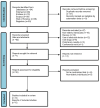Impact of Different Types of Physical Exercises for the Management of Older Women with Urinary Incontinence: A Systematic Review of Randomized Clinical Trials
- PMID: 40429419
- PMCID: PMC12111961
- DOI: 10.3390/jcm14103425
Impact of Different Types of Physical Exercises for the Management of Older Women with Urinary Incontinence: A Systematic Review of Randomized Clinical Trials
Abstract
Background/Objectives: Urinary incontinence (UI) is particularly prevalent in women of all ages, but especially in older women, due to risk factors that contribute to pelvic floor muscle weakness. Urinary incontinence can have a significant psychosocial impact and compromise the quality of life of affected women. It is reported that physical activity seems to be inversely associated with UI. The aim is to summarize the impact of different modalities of physical exercises in management of older women with UI. Methods: Searches were performed in the databases PubMed, Web of Science, EMBASE and Scopus. The searches were performed on 10 December 2024. Only randomized clinical trials were included. Ninety-three papers were initially screened, and five full papers reached all the inclusion criteria describing the effects of exercise on urinary incontinence. The studies included a total of 352 elderly participants aged 60 years or older. Of these participants, 268 lived in nursing homes and 84 lived in a local community. The intervention period varied among the selected studies from 6 weeks to 12 months, and in general, the pelvic floor training was used. Results: Improvements in the quality of life and in the physical performance of the older women with UI were reported, although the risk of bias was classified as "some concerns". Conclusions: Moreover, it is revealed that different types of exercises are used to "work" the pelvic floor muscle and contribute, in general, to reducing the symptoms, and improving the quality of life of older women with UI due to the positive impact of the exercises.
Keywords: pelvic floor muscle; physical performance; quality of life; urinary incontinence.
Conflict of interest statement
The authors declare no conflict of interest.
Figures


Similar articles
-
Effectiveness of a pelvic floor muscle exercise program on urinary incontinence following childbirth.Int J Evid Based Healthc. 2005 May;3(5):103-46. doi: 10.1111/j.1479-6988.2005.00023.x. Int J Evid Based Healthc. 2005. PMID: 21631746
-
Basic versus biofeedback-mediated intensive pelvic floor muscle training for women with urinary incontinence: the OPAL RCT.Health Technol Assess. 2020 Dec;24(70):1-144. doi: 10.3310/hta24700. Health Technol Assess. 2020. PMID: 33289476 Free PMC article. Clinical Trial.
-
Behavioural interventions for urinary incontinence in community-dwelling seniors: an evidence-based analysis.Ont Health Technol Assess Ser. 2008;8(3):1-52. Epub 2008 Oct 1. Ont Health Technol Assess Ser. 2008. PMID: 23074508 Free PMC article.
-
Pelvic floor muscle training for preventing and treating urinary and faecal incontinence in antenatal and postnatal women.Cochrane Database Syst Rev. 2020 May 6;5(5):CD007471. doi: 10.1002/14651858.CD007471.pub4. Cochrane Database Syst Rev. 2020. PMID: 32378735 Free PMC article.
-
Pelvic floor muscle training versus no treatment, or inactive control treatments, for urinary incontinence in women.Cochrane Database Syst Rev. 2018 Oct 4;10(10):CD005654. doi: 10.1002/14651858.CD005654.pub4. Cochrane Database Syst Rev. 2018. PMID: 30288727 Free PMC article.
References
-
- Flint B., Tadi P. StatPearls [Internet] StatPearls Publishing; Treasure Island, FL, USA: 2024. Physiology, Aging. - PubMed
Publication types
LinkOut - more resources
Full Text Sources

